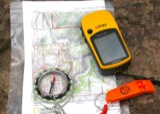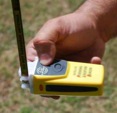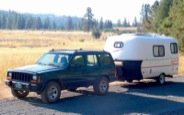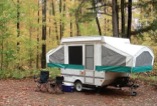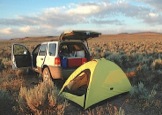Less Traveled Northwest
Day Hikes for the Adventurous
Skills and Equipment for Backcountry Travel
Are Special Skills or Devices Needed?
The ability to read a topographic map and use a compass are the most essential skills. We provide topo maps as a PDF download for each hike, with the trails clearly marked. Where there is no official trail, GPS waypoints are given, both on the topo map and as a GPX download file. With advanced map reading skills, a GPS unit may not be strictly needed, but it’s wise to have one along and know how to use it.
When driving and hiking in remote areas, we also recommend that each group carry an emergency satellite locater unit, such as a satellite messenger or a personal locator beacon (PLB) — and know how to use it. As cell phone service is almost never available, these units provide insurance and peace of mind in case of a vehicle breakdown or a serious injury in a remote location.
The most important travel skill, however, is accurate self-knowledge. Knowing your own limitations and always staying within them is essential. In any situation, if strong doubts arise about your skills, your equipment, the health of anyone in your group, the weather or the road conditions, it’s smart not to press forward. The old adage, “discretion is the better part of valor,” is particularly true for backcountry travel!
Best Method for Camping and Traveling?
If your primary interest is day hiking, the best arrangement is to have your camping setup separate from your travel vehicle. This allows you to establish yourself at a particular camping spot (whether in a tent on the ground, a tent trailer or small travel trailer), then have your vehicle free to drive to the trailheads. If you don’t mind breaking down your campsite each morning before driving to the trailhead, then a pickup camper, camper van or small RV may also work — but these can be cumbersome and inefficient.
Options for Camping on Public Land?
Developed campgrounds are found on nearly all lands managed by the Forest Service, but in only a few backcountry areas managed by the BLM. These feature designated campsites, picnic tables, fire rings, vault toilets — plus, they may supply drinking water — all for a small fee. In addition, the USFS and BLM maintain smaller and more remote forest or desert camps, which rarely have designated campsites, or drinking water or charge a fee — but will always have a vault or pit toilet.
Finally, a third option is dispersed camping, which means camping anywhere on Forest Service or BLM lands outside of a developed campground, at no fee. This can be a good choice in remote areas (sometimes the only choice), especially if you're properly prepared and have the right camping equipment. However, there are a few official rules:
• You must supply your own water, sanitation and trash disposal.
• Avoid camping within 100 feet of any stream, lake or water source.
• Don't camp in the middle of a clearing or meadow (make your campsite less visible).
• Camp within 150 feet of an existing roadway.
• Camp in a previously used spot, if possible.
• Avoid building new fire rings.
• Use only dead or downed wood for campfires.
• Use your own portable toilet, especially at heavily-used sites.
• Pack out all of your own trash.
What about Sanitation at Dispersed Campsites?
It depends on the camping context. Ideally, all dispersed campers would use a portable toilet and be entirely responsible for their own human waste. This is most critical at dispersed campsites that are heavily used, say, receiving 4 or more visits per year. Burying your waste in a "cat hole" here just isn't responsible — as coyotes will likely dig it up anyway. However, this practice can be perfectly acceptable at other dispersed campsites that are very rarely or never used.
Is a Four-Wheel Drive Vehicle Needed?
Generally, no, if you're traveling during the June through September hiking season, after the roads have dried out. However, a high clearance vehicle (SUV, pickup or passenger car) is strongly recommended. The primary roads on federal lands are usually very good (often paved or graded gravel) and these can be driven with any vehicle. But the dirt secondary roads that lead to remote trailheads occasionally have stretches of deep ruts or exposed rocks that require high clearance.
If you already have four-wheel drive, though, it can be good insurance — provided you use it wisely. In our experience, it's best to stay in two-wheel drive exclusively, up until you start losing traction or getting into trouble. Then, switch to four-wheel drive only to get out of trouble. If you get your vehicle stuck while using four-wheel drive, it usually means you're already well beyond self-recovery.
Though 4-wheel drive is optional, good quality tires are not. Since 90% of backcountry driving is on gravel or dirt roads with exposed rocks, it’s essential to have durable tires in good condition. We recommend at least 6-ply tires, on both your main vehicle and any trailer. Even on well-graveled primary roads, 4-ply passenger car tires can break down quickly — especially on recently graded roads with freshly exposed, sharp rocks.
Other Essential Equipment for Backcountry Travel?
This safety gear should always be stashed in your vehicle on every trip:
• Extra Water (we plan on 3 gallons/person/day when remote camping)
• Extra Gas (a steel 5-gallon can)
• Small Chain Saw (for clearing deadfall trees on remote forest roads)
• Shovel
• Axe
• High-lift or Hydraulic Jack
• Portable 12-volt Jump Starter and Air Compressor
• Jumper Cables
• Nylon Tow Strap
• First Aid Kit
• Basic Repair Kit (tape, epoxy glue, wire, etc.)
• Spare vehicle belts, electrical fuses, etc.
• Spare Tire (fully inflated!)
• Tool box, with basic mechanic’s tools
Page last updated: 12/16/13

